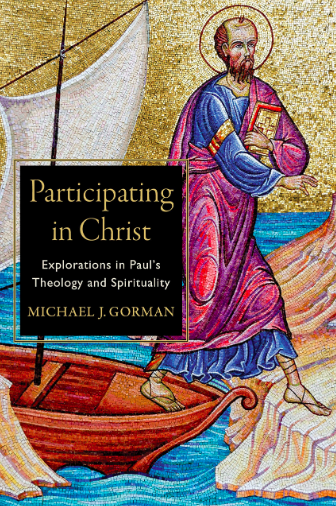We’ve been looking at the essays in a book Theology After Darwin centered around a simple question: What are the implications for Christian theology if Darwin was right? In conjunction with this we are also looking at three articles in the recent theme issue of the ASA Journal Perspectives on Science and Christian Faith (v. 62 no. 3 2010) Reading Genesis: The Historicity of Adam and Eve, Genomics, and Evolutionary Science.
 On Tuesday we began a discussion of the article by Daniel C. Harlow, After Adam: Reading Genesis in an Age of Evolutionary Science (pp. 179-195 – pdf available at the link to the left). Dr. Harlow a professor of religion at Calvin College, he obtained his Ph.D. at Notre Dame studying the ever fascinating Greek Apocalypse of Baruch (3 Baruch). In his article in PSCF he takes a nonconcordist approach to Genesis and looks at the text as story rather than history. He considers Adam and Eve as symbolic literary figures. We discussed the portion of his article where he puts forth his reasons for this conclusion in the last post.
On Tuesday we began a discussion of the article by Daniel C. Harlow, After Adam: Reading Genesis in an Age of Evolutionary Science (pp. 179-195 – pdf available at the link to the left). Dr. Harlow a professor of religion at Calvin College, he obtained his Ph.D. at Notre Dame studying the ever fascinating Greek Apocalypse of Baruch (3 Baruch). In his article in PSCF he takes a nonconcordist approach to Genesis and looks at the text as story rather than history. He considers Adam and Eve as symbolic literary figures. We discussed the portion of his article where he puts forth his reasons for this conclusion in the last post.
The next part of his article looks at the consequence of taking Genesis 2-3 on its own terms and looks as well at Paul and his discussion in Romans 5. Dr. Harlow upholds what he considers a viable doctrine of both original sin and the fall. He finds the biblical support for these doctrines, not in Genesis or the Old Testament, but in Paul. The doctrines don’t stand or fall with a historical Adam, he suggests, but with the gospel of Jesus Christ preached by Paul.
Do you think there is any evidence in the Bible to support the doctrine of Original Sin prior to Paul?
Sin, Death, and the Fall. One of the first things to note here is that our classical doctrines of sin and death are rooted not in the text of Genesis in itself, but in interpretations of Genesis; in the interpretation of Paul, but even more significantly in the interpretations of Augustine. Peter Bouteneff’s book Beginnings: Ancient Christian Readings of the Biblical Creation Narratives is a study of the early interpretation of Genesis in both Jewish and Christian sources. Dr. Harlow refers to this book often in his discussion. His purpose here is not to undermine the doctrines of sin and death or to declare them wrong, but to understand their real source in our Christian tradition.
Harlow’s main points, quoted from the article:
- Read on its own, Genesis does not teach that the first human beings were created immortal and that death entered the world only after and as a consequence of their transgression. … According to Genesis, then, human death was a natural part of God’s created world, not part of the fallout of a fall. (p. 188) (This is a point I’ve made on a number of posts. It is self-evident in the text.)
- Genesis itself does not picture the first humans being created in a state of spiritual maturity and moral perfection. (p. 188)
- Genesis 3, read in its immediate context, does not depict the man and woman’s transgression as an act that infected all subsequent humanity. (p. 189)
- the Adam and Eve story does not have as its main themes sin and death but knowledge and immortality. The “knowledge of good and evil” the couple gain by eating of the fruit is the experience of autonomous wisdom—deciding what is right without reference to the divine will, and having to face unforeseen but inevitable consequences. (p. 189)
- not only are Adam and Eve nowhere referred to elsewhere in Hebrew Scripture, but the rest of the Old Testament (and the New Testament apart from Paul) assumes that sin is avoidable. This is true already in the story of Cain, (p. 189)
Adam, Christ, and Paul. Other than the stylized reference in the genealogy of Luke, Adam is mentioned in the NT only by Paul. Jesus references the fact that God instituted marriage as told in Gen. 2, but does not reference Adam, Eve, or Gen. 3. The key passages in the letters of Paul are found in Romans 5:12-21 and 1 Cor. 15:21-22; 45-49. It is common for evangelical interpreters to state that because Christ was a unique historical individual Paul’s typology, and his Christology, will fail if Adam was not a unique historical individual. This kind of reasoning has problems and twists the typology to use it as a proof for historicity. Whether Adam is a unique historical individual or not this “proof” reasoning fails. Harlow here quotes Dunn’s commentary on Romans and adds some comments:
It would not be true to say that Paul’s theological point here depends on Adam’s being a “historical” individual or on his disobedience being a historical event as such. Such an implication does not necessarily follow from the fact that a parallel is drawn with Christ’s single act: an act in mythic history can be paralleled to an act in living history without the point of comparison being lost. So long as the story of Adam as the initiator of a sad tale of human failure was well known…such a comparison was meaningful… [T]he effect of the comparison between the two epochal figures, Adam and Christ, is not so much to historicize the individual Adam as to bring out the more than individual significance of the historic Christ. (Dunn, Romans 1-8)
In formulating his typology, Paul’s main interest is to depict Christ as a representative figure, one whose act affected not only himself but the entire human race. He brings in Adam less as a figure of history than as a type of Christ – a symbolic stand-in for fallen humanity. Paul, like Luke, no doubt regarded Adam as a historical person, but in his letters he assumes the historicity of Adam instead of asserting it, … (Harlow p. 190)
Harlow builds a case that Paul taught that sin entered through Adam but that death spread to all because all sinned.
Adam was the first sinner, but humanity’s sin falls squarely on the human race as a whole. … [Paul] attributes to Adam less a casual role in the sin of all humanity than a temporal and representative one. (p. 190)
This view is also found in a number of other ancient sources, including 2 Baruch (a Jewish apocalypse near contemporary with Paul) and Justin Martyr’s Dialogue with Trypho. And this leads to a key conclusion.
If this reading is right, then Paul is not really the initiator of the doctrine of original sin. That credit must go rather to Jerome, whose Latin translation of Rom. 5:12, which says that Adam was the one “in whom” (in quo) all humanity sinned, and was taken up and interpreted by Augustine. (p. 190)
Paul reasoned from Christ – the solution – back to the the human condition and humanity’s need for redemption. The entire discussion is Christ-centered not man centered. Quoting from Bouteneff, Harlow emphasizes a key point, one central to Christian faith: Christ is the beginning and the end, the first true human being, and the model or image for humanity. Christ is not a patch to fix what went wrong (what we did wrong).
Original Sin. Clearly, if this is correct we need some rethinking of the nature of the doctrine of original sin – the transmission and ontological nature of Original Sin. Yet neither evolution, nor a literary interpretation of Gen 2-3 as story undermines the theological truth of Gen 2-3, the teachings of Paul, or the insights of Augustine. Augustine’s “theological intuition” concerning the inevitability of sin and the inability of human beings to overcome or avoid sin remains as true today as it was 1500 years ago. His understanding of how and why needs some serious reconsideration. Truth remains truth, yet every generation has and must recast and rethink the formulations of key doctrines. Harlow concludes his article with a call for a theological recasting of the classical doctrines of Christian faith.
For Christianity to remain intellectually credible and culturally relevant, it must be willing to revise – and thereby enrich – its formulation of classic doctrines if the secure findings of science call for revision. The task of Christian theology in every generation is not simply to repeat or paraphrase the tradition but to re-present it in fresh ways so that it can continue to speak meaningfully. Doctrines invite revisiting and possible reformulation when the church is confronted with new interpretations of Scripture and new understandings of the theological tradition, with new insights from the creation itself, and with new challenges from contemporary intellectual culture.
Where do we go from here? There are several key points raised in Dr. Harlow’s article. The most important relate to the biblical foundation for the doctrine of Original Sin. While the doctrine of human sinfulness and the inevitability of sin are well founded in scripture, the concept of sin as infection from Adam to all mankind has little, if any, biblical support. Reading Genesis 2-3 on its own terms teaches no such thing. Paul can be interpreted in this fashion – but it is far from the only possible interpretation. The classical formulation of Original Sin by Augustine uses an inaccurate translation of Romans 5 by Jerome. The truth revealed in God’s creation, in the evidence for common descent, belies this interpretation.
These points are worth discussion. But Harlow’s approach to Paul and Romans 5 is not the only one out there – and it is certainly not the last word on the issue, even for our generation. Henri Blocher’s book Original Sin contains a different look at some of these same issues in an intellectually credible fashion, with an approach that retains a much higher level of concordism. Blocher agrees with Harlow that we must revisit doctrines and stand on the shoulders of those who came before to enable us to see farther. He maintains belief in a literal Adam along the lines of the options given in the last post, but not because of Original Sin. In fact he also argues that the ontological aspect of original sin as infection misreads Paul. Blocher suggests that Paul did not consider sin as existing without law – it was simply undefined. Thus Romans 5 does not really deal with Original Sin. The role of Adam and of his sin in Romans 5 is “to make possible the imputation, the judicial treatment, of human sins.”
What do you think? Is original sin as infection from Adam to the entire human race found in scripture? Is it an explicit teaching, a plausible inference, or a mistaken reading?
And another issue that comes up often in this discussion,
Is it reasonable to let science, our observation of the world, influence our selection between possible interpretations of the biblical witness?
If you wish to contact me directly you may do so at rjs4mail[at]att.net.
If interested you can subscribe to a full text feed of my posts at Musings on Science and Theology.











